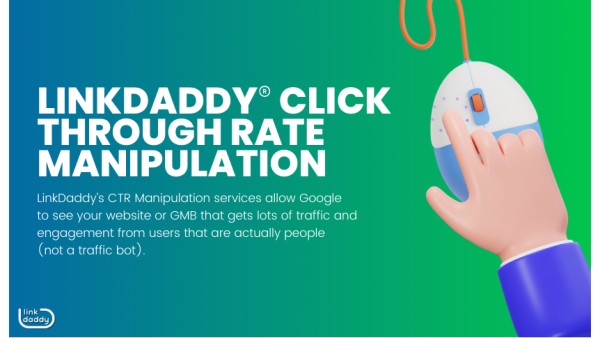Elevate Your Business Presence with Our CTR Manipulation Service
Elevate Your Business Presence with Our CTR Manipulation Service
Blog Article
Maximizing Organic Click-Through Fees With CTR Control
The optimization of organic click-through rates (CTR) is a nuanced endeavor that hinges on understanding both individual psychology and effective material discussion. The landscape is swarming with false impressions and oversimplifications regarding what absolutely drives CTR.
Understanding Click-Through Fees
Recognizing click-through rates (CTR) is important for evaluating the effectiveness of on the internet advertising methods. CTR determines the percent of customers who click a specific link or advertisement contrasted to the total number of users who view it. A greater CTR indicates that the content is engaging and relevant to the target audience, while a lower CTR may indicate a demand for optimization.
To calculate CTR, split the variety of clicks by the number of perceptions and multiply by 100. If an advertisement gets 300 clicks out of 10,000 perceptions, the CTR would be 3%. This metric is crucial for examining different components of electronic advertising and marketing, including search engine optimization (SEARCH ENGINE OPTIMIZATION), e-mail campaigns, and social media sites marketing.
Moreover, assessing CTR aids marketing experts recognize which approaches produce the best outcomes and which require improvement. By focusing on improving CTR, companies can boost their content's presence and efficiency, resulting in increased traffic and prospective conversions. Recognizing the nuances of CTR is foundational for any type of marketing expert intending to enhance their on the internet visibility and optimize return on financial investment (ROI)

The Psychology of Individual Behavior
User behavior is significantly influenced by psychological elements that dictate how people interact with on-line web content. Understanding these factors is necessary for optimizing click-through rates (CTR) in organic search results page. Cognitive prejudices, such as the anchoring result, play a crucial function fit customers' understandings. When customers experience details, their initial impacts can greatly affect their subsequent judgments about importance and reliability.
Psychological responses likewise dramatically effect individual behavior. Web content that resonates psychologically can trigger a feeling of seriousness or inquisitiveness, triggering customers to click. Furthermore, social proof-- such as customer reviews or ratings-- can improve trust fund and urge engagement, as individuals commonly want to the actions of others to educate their very own choices.
Furthermore, the concept of scarcity can drive clicks - CTR Manipulation Press Release. Limited-time deals or unique web content produce a worry of missing out (FOMO), engaging users to act quickly. Comprehending these mental chauffeurs makes it possible for marketing professionals to develop more engaging content that reverberates with their target market
Efficient CTR Manipulation Techniques
Leveraging psychological insights can significantly improve click-through prices (CTR) through targeted adjustment techniques. Among the most reliable techniques is the usage of compelling headings that evoke curiosity or urgency. Wording titles as inquiries or integrating numbers can bring in more attention, prompting customers to click.
Another method involves maximizing meta summaries to create a feeling of relevance and immediacy. By plainly outlining the benefits or services given in the web content, you can engage prospective readers and convince them to click. Furthermore, making use of power words-- such as "unique," "verified," or "cost-free"-- can enhance the charm of your material.
Visual components additionally play a critical function. Incorporating captivating photos or thumbnails can attract customers in and boost CTR. A/B screening different visuals can assist determine which my review here images reverberate best with your audience.
Finally, making certain that your material assures deliverable value leads to greater CTR. They are a lot more likely to engage when users perceive that clicking will certainly supply them with purposeful understandings or solutions. By utilizing these methods attentively, marketing professionals can effectively adjust CTR to their benefit while maintaining ethical requirements.
Common Myths Regarding CTR
Numerous misunderstandings surround click-through rates (CTR) that can lead marketing experts to make misdirected choices. While a high CTR recommends that more individuals are clicking, it does not guarantee conversions or sales.
Another common idea is that CTR is an isolated metric. Actually, CTR needs to be examined along with other performance indicators, such as bounce rate and conversion price, to get an all natural view of project success.
Additionally, some marketing experts assume that maximizing for CTR alone suffices. Nonetheless, focusing specifically on CTR can result in clickbait strategies that might attract clicks yet stop working to involve individuals meaningfully. This approach can harm brand track record and cause reduced retention prices
Last but not least, there is an idea that CTR strategies are universally effective. The truth is that ideal CTR methods can differ dramatically across industries and target market, necessitating customized approaches for various market segments. Comprehending these misconceptions is essential for creating efficient CTR techniques that straighten with overarching advertising and marketing goals.
Determining CTR Success
Although high click-through rates (CTR) can show successful interaction with web content, measuring their true success needs a thorough analysis of several aspects. It is vital to recognize the context in which the CTR is accomplished. For circumstances, a high CTR on a deceptive title may not translate to significant involvement or conversions, ultimately showing inadequately on the brand name's trustworthiness.
2nd, evaluating the resource of traffic is important. Organic website traffic from internet search engine can symbolize a robust content technique, while clicks from irrelevant resources may suggest a lack of targeting. Additionally, determining the succeeding customer actions is essential; analyzing metrics such as Visit Your URL bounce price, time spent on web page, and conversion prices can offer much deeper understandings right into the quality of the interaction initiated by the CTR.

Conclusion

The optimization of organic click-through rates (CTR) is a nuanced venture that hinges on recognizing both customer psychology and efficient web content discussion. CTR determines the percent of users who click on a specific link or advertisement contrasted to the overall number of users who watch it. A greater CTR indicates that the web content is involving and relevant to the target audience, while a reduced CTR might indicate a requirement for optimization.
Focusing solely on CTR can lead to clickbait methods that may attract clicks but stop working to engage customers meaningfully. Additionally, measuring the succeeding individual habits is essential; examining metrics such as bounce price, time why not find out more invested on web page, and conversion prices can give deeper understandings right into the top quality of the engagement initiated by the CTR.
Report this page